EVERYTHING NEEDS A RETOUCH
30-year-old Jess is a mess. A New York-based dotcom genius, Jess is fraught with low self-esteem, making her an overweight, smelly, anti-social, stressed-out, aggressive, iconoclastic nerd who picks at her zits. She tells fellow nerd and co- worker Lewis during lunch at Chipotle that her mother, estranged for years, is dying back home in Little Rock. She doesn’t want to go’”the memories are too painful and it will no doubt remind her of how she came to be such a mess.
worker Lewis during lunch at Chipotle that her mother, estranged for years, is dying back home in Little Rock. She doesn’t want to go’”the memories are too painful and it will no doubt remind her of how she came to be such a mess.
Exciting playwright Sheila Callaghan (Crumble (Lay Me Down, Justin Timberlake), Lascivious Something) will send her protagonist on a mind-bending, time-traveling, post-modern journey in Everything You Touch, now receiving a world premiere at The Theatre @ Boston Court (co-produced by New York’s Rattlestick Playwrights Theater).
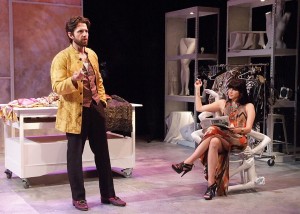 Flip to 1975. Told concurrently with Jess’s story is that of fashion designer Victor, a skinny, chain-smoking, well-dressed, bratty narcissist who runs his haute couture boutique with his protégé, muse, and lover Esme, a stunning drama queen who takes no shit. His business is barely surviving, and both of them are as brutal as New York on a hot, humid day. Into their world comes Louella, a cheery mid-western type who has won a promotion for a two-day VIP fashion treatment. When Victor asks Louella to stay and consult him on a new and more accessible line, it sets into motion a story which will lead back to Jess and her mother.
Flip to 1975. Told concurrently with Jess’s story is that of fashion designer Victor, a skinny, chain-smoking, well-dressed, bratty narcissist who runs his haute couture boutique with his protégé, muse, and lover Esme, a stunning drama queen who takes no shit. His business is barely surviving, and both of them are as brutal as New York on a hot, humid day. Into their world comes Louella, a cheery mid-western type who has won a promotion for a two-day VIP fashion treatment. When Victor asks Louella to stay and consult him on a new and more accessible line, it sets into motion a story which will lead back to Jess and her mother.
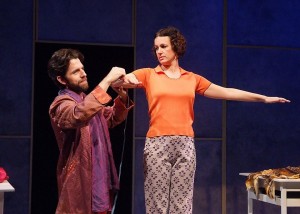 The dialogue in the confusing and overlong first act continually drops hints that not all is what it seems, but any further plot points are spoilers. The marvelous production values at Boston Court are as impressive as ever, but this is a structurally flawed script’”so much so that director Jessica Kubzansky has yet to locate the beating heart of the play. It’s a strong enough script, especially in dialogue and story, but the playwright’s deconstructive dramaturgy complicates the story rather than enhancing it. A truckload of love and sweat has gone into the script development and this production. Even at what I consider a workshop phase, there is enough intriguing stuff going on to warrant a visit. Suffice it to say that not only does the protagonist come home in the second act, so does the play.
The dialogue in the confusing and overlong first act continually drops hints that not all is what it seems, but any further plot points are spoilers. The marvelous production values at Boston Court are as impressive as ever, but this is a structurally flawed script’”so much so that director Jessica Kubzansky has yet to locate the beating heart of the play. It’s a strong enough script, especially in dialogue and story, but the playwright’s deconstructive dramaturgy complicates the story rather than enhancing it. A truckload of love and sweat has gone into the script development and this production. Even at what I consider a workshop phase, there is enough intriguing stuff going on to warrant a visit. Suffice it to say that not only does the protagonist come home in the second act, so does the play.
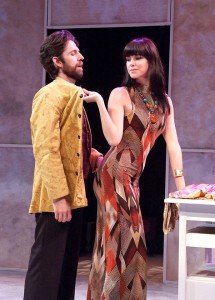 Scenes can positively crackle with Callaghan’s droll and knowing lines. However, while Jess spews out comebacks with the best of them, it is only Victor and Esme who emerge triumphant as two of the most fascinating characters in this or any script. That may be due to their lack of introspective capabilities: Other characters are simply and laboriously too self-aware for us to be on a journey of discovery with them. The scenes with the charmingly neurotic Tyler Pierce as Victor and the ravishing spitfire Kate Maher as Esme are alone worth the price of admission.
Scenes can positively crackle with Callaghan’s droll and knowing lines. However, while Jess spews out comebacks with the best of them, it is only Victor and Esme who emerge triumphant as two of the most fascinating characters in this or any script. That may be due to their lack of introspective capabilities: Other characters are simply and laboriously too self-aware for us to be on a journey of discovery with them. The scenes with the charmingly neurotic Tyler Pierce as Victor and the ravishing spitfire Kate Maher as Esme are alone worth the price of admission.
Louella (a straightforward Amy French) appears as one of the necessary puzzle pieces to round out the drama, but she is not a fully fleshed-out character’”and coincidentally the only one who is not hyper-literate. In the end, Louella’s fate is nebulous at best.
There are a few reasons why it takes a while to get on board, and it’s not because we flip back and forth between the 70s (Victor’s story) and the present day. Plenty of hints about what is actually going on are dropped in the first act, but the information has trouble sticking because it’s unclear whether this is a memory play or a puzzle play which eventually comes together in the end. Adding to the intended  mystery, Victor shows up in Jess’s life early in the play and they start an affair: Is it cyber? Imagined? Real? Only time will tell.
mystery, Victor shows up in Jess’s life early in the play and they start an affair: Is it cyber? Imagined? Real? Only time will tell.
As played by Kirsten Vangsness, Jess isn’t endearing or vulnerable; she’s just a schlubby but well-spoken loser. Frankly, it’s difficult to see what is so appealing about her to Arthur Keng’s delightfully chatty computer nerd Lewis, who is in love with her, and Pierce’s handsome fashion designer’”whether he is real or not. A more distinctive actress may have helped, but ultimately Jess’s arc is unconvincing. The main thrust of the play is about overweight women in a skinny world, not overcoming dismissive parents.
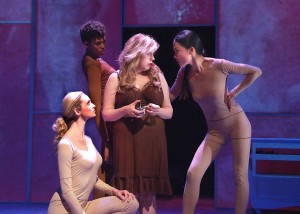 The thorniest issue is that the play is locked-in by its own directorial conceit. The script actually instructs the production to use a cheeky and extraordinarily clever device which eventually backfires: In the scenes involving Jess, there are three tall, skinny models (Allegra Rose Edwards, Chelsea Fryer, and Candice Lam) clad in skin-tight, flesh-colored, stretchy fabric. They roll furniture around in the scene changes, and wear funky hats that represent the scene (a lamp, a telephone); one even has a Gideon Bible applied to her bosoms in a motel room scene. The models also speak hateful words once uttered by Jess’s mother, but if Jess is delusional enough to hang out with Victor, why can’t she hear the hateful lines come from Lewis or the phone or an overhead speaker at Chipotle? Having the models around the entire play leaves us to wonder if the scenes before us are real or in Jess’s imagination. Instead of being titillating, it eventually serves to alienate. The models become glorified stage hands, and watching them clicking locks on the casters before each new scene becomes wearisome. By creating this metatheatrical trickery, Callaghan is unnecessarily commenting on her own story.
The thorniest issue is that the play is locked-in by its own directorial conceit. The script actually instructs the production to use a cheeky and extraordinarily clever device which eventually backfires: In the scenes involving Jess, there are three tall, skinny models (Allegra Rose Edwards, Chelsea Fryer, and Candice Lam) clad in skin-tight, flesh-colored, stretchy fabric. They roll furniture around in the scene changes, and wear funky hats that represent the scene (a lamp, a telephone); one even has a Gideon Bible applied to her bosoms in a motel room scene. The models also speak hateful words once uttered by Jess’s mother, but if Jess is delusional enough to hang out with Victor, why can’t she hear the hateful lines come from Lewis or the phone or an overhead speaker at Chipotle? Having the models around the entire play leaves us to wonder if the scenes before us are real or in Jess’s imagination. Instead of being titillating, it eventually serves to alienate. The models become glorified stage hands, and watching them clicking locks on the casters before each new scene becomes wearisome. By creating this metatheatrical trickery, Callaghan is unnecessarily commenting on her own story.
Kubzansky, who helped develop the piece (which had scenes shuffled during previews) has an imagination firing on all cylinders, but an over-stylized production (which is practically becoming a Kubzansky and Boston Court trademark) often exacerbates the script’s shortcomings. François-Pierre Couture’s set has omnipresent utility shelves replete with white mannequin parts and a chair made of the same 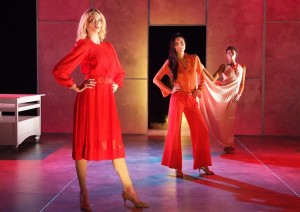 that I swear could be mass produced to raise money for another production.
that I swear could be mass produced to raise money for another production.
But I wish Kubzansky had delineated space and time more. At the top, a model falls to the floor during a runway walk. We get a truckload of rich character insight from Victor during his hysterical monologue berating her for a lack of “barbaric elegance” (the dialogue is one of the play’s best assets). But it is unclear where we are: The runway? His office? Backstage? I would have preferred specificity of space, perhaps with other models and Esme watching the poor girl being shamed. This way, the damaged pride of the model would become more visceral, and her ensuing suicide much more palpable.
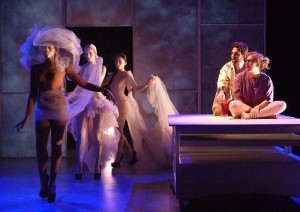 Speaking of which, at the top of the show we witness the most amusing and jaw-dropping fashion show in theater history. Jenny Foldenauer’s soon-to-be award-winning costume design echoes a style review which is read by Esme: “The gothic, the treacherous, and the peculiar.” I see the female fashions as an über-clever mash up of Star Wars, Coco Chanel, and Kink.com. Later, Foldenauer’s line of 70’s wear, which is mass produced for sale at Dillard’s, is a riotous collision of 50’s housewife, 60’s mod, and 70’s exaggerated sunniness set in rich and ghastly-but-gorgeous autumnal colors.
Speaking of which, at the top of the show we witness the most amusing and jaw-dropping fashion show in theater history. Jenny Foldenauer’s soon-to-be award-winning costume design echoes a style review which is read by Esme: “The gothic, the treacherous, and the peculiar.” I see the female fashions as an über-clever mash up of Star Wars, Coco Chanel, and Kink.com. Later, Foldenauer’s line of 70’s wear, which is mass produced for sale at Dillard’s, is a riotous collision of 50’s housewife, 60’s mod, and 70’s exaggerated sunniness set in rich and ghastly-but-gorgeous autumnal colors.
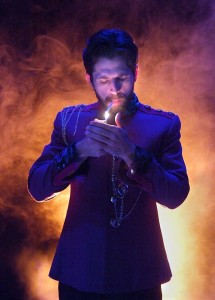 The enormously successful scenes involving Victor and Esme just happen to be uncontrived, which is what leads me to believe that a perfectly simple story has been corrupted. And what of future productions? Will they be forced to honor Callaghan’s stage directions or will a different director be able to add their own spin?
The enormously successful scenes involving Victor and Esme just happen to be uncontrived, which is what leads me to believe that a perfectly simple story has been corrupted. And what of future productions? Will they be forced to honor Callaghan’s stage directions or will a different director be able to add their own spin?
“Why are we doing all the work?” a friend asked after he saw the show. If Callaghan (or Kubzansky for that matter) simply must be post-modern, don’t leave us in limbo for quite so long that we lose a willingness to do the work required to appreciate the effort.
photos by Ed Krieger
Everything You Touch
The Theatre @ Boston Court
Boston Court Performing Arts Center
70 North Mentor Avenue in Pasadena
scheduled to end on May 11, 2014
EXTENDED to May 18, 2014
for tickets, call (626) 683-6883 or visit www.BostonCourt.org


{ 1 comment… read it below or add one }
Great review. Thanks.